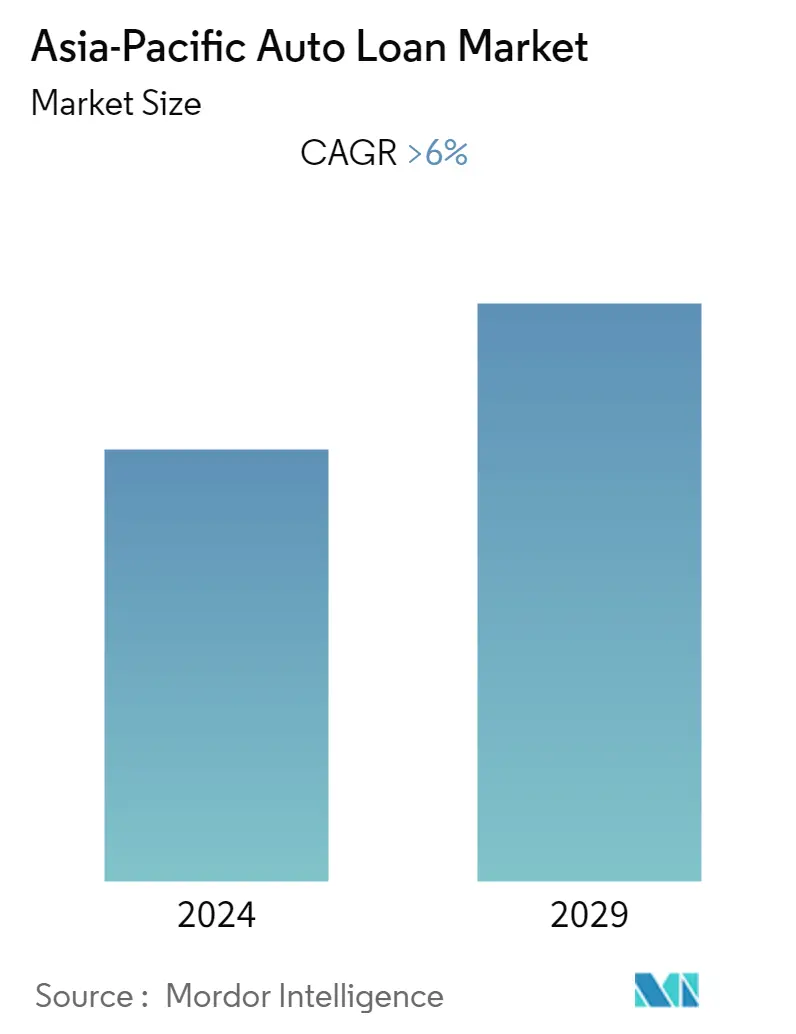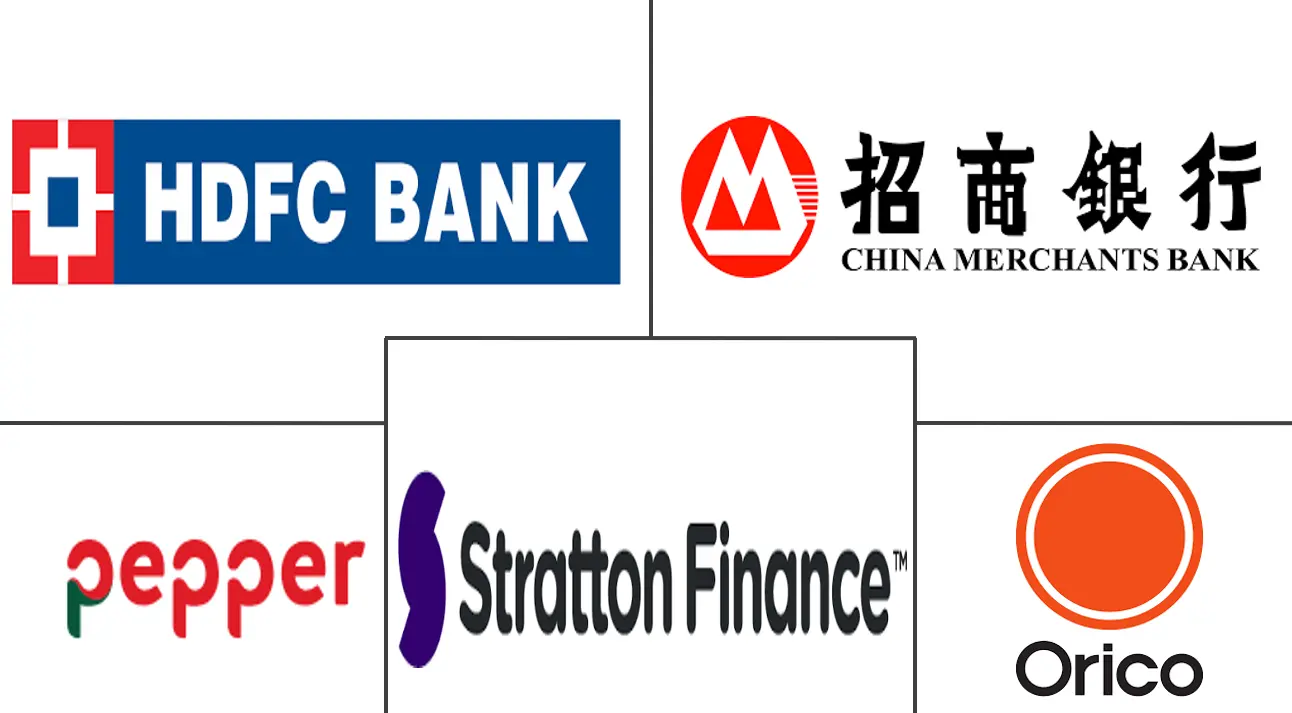Market Size of Asia-Pacific Auto Loan Industry

| Study Period | 2020 - 2029 |
| Base Year For Estimation | 2023 |
| Forecast Data Period | 2024 - 2029 |
| Historical Data Period | 2020 - 2022 |
| CAGR | 6.00 % |
| Market Concentration | Medium |
Major Players
*Disclaimer: Major Players sorted in no particular order |
Asia-Pacific Auto Loan Market Analysis
The Asia-Pacific auto loan market has a transaction value of USD 1.23 Trillion in the current year and is poised to register a CAGR of more than 6% for the forecast period.
Sales of automobiles in the Asia-Pacific region are observing continuous growth, resulting in an increasing number of people opting for loan options while purchasing their vehicles. China, India, and Japan are among the existing Asia-Pacific countries with the largest sales volume of automobiles. In addition to this, India, China, and Indonesia exist as the Asia-Pacific countries with the highest interest rate on bank loans, making automobile loans a profitable business in these regions with an existing higher rate of risk premium.
In the Asia-Pacific region, credit unions are emerging as competitive players in the auto loan business as they can provide borrowers with a lower interest rate in comparison to commercial banks, reducing the loan cost of the borrower. Entry of fintech and NBFC firms into the automobile credit business is helping to expand sales of new and used automobiles in the region. Post-COVID-19, sales volume and revenue of passenger vehicles have observed a sharp rise in the region.
With rising innovation and changing business model of banking in the region, loans on electric vehicles are emerging as a new segment in the automobile market with existing subsidies and a lower rate of interest on them. Asia-Pacific is observing a continuous increase in car ownership rates by households, resulting in banks, credit unions, and other loan issuers making available instant loans through the launch of their digital platforms to capture a significant share of the market.
Asia-Pacific Auto Loan Industry Segmentation
An automobile loan allows a user to borrow money from a lender and use it to purchase different forms of vehicles, which include Passenger and commercial vehicles. The loan is paid back to the issuer in the form of installments over some time with an agreed amount of interest payment.
The Asia-Pacific auto loan market is segmented by vehicle type (passenger vehicles, commercial vehicles), ownership (new vehicles, used vehicles), end-user (residential, enterprise), loan provider (banks, OEMs, credit unions, and other loan providers), and country (China, Japan, India, Australia, South Korea, and the Rest of Asia-Pacific).
The report offers market sizes and forecasts for the Asia-Pacific auto loan market in value (USD) for all the above segments.
| By Vehicle Type | |
| Passenger Vehicle | |
| Commercial Vehicle |
| By Ownership | |
| New Vehicle | |
| Used Vehicle |
| By End-User | |
| Individual | |
| Enterprise |
| By Loan Provider | |
| Banks | |
| OEM | |
| Credit Unions | |
| Other Loan Providers |
| By Country | |
| China | |
| Japan | |
| India | |
| Australia | |
| South Korea | |
| Rest of Asia-Pacific |
Asia-Pacific Auto Loan Market Size Summary
The Asia-Pacific auto loan market is experiencing robust growth, driven by increasing automobile sales and a rising trend of consumers opting for financing options to purchase vehicles. Key countries such as China, India, and Japan are leading in sales volume, while India, China, and Indonesia are noted for having higher interest rates on bank loans, which enhances the profitability of auto loans despite the associated risks. The market is becoming increasingly competitive with the emergence of credit unions offering lower interest rates compared to commercial banks, and the entry of fintech and non-banking financial companies (NBFCs) is further expanding the market. The post-COVID-19 recovery has seen a significant rise in passenger vehicle sales, with electric vehicle loans gaining traction due to subsidies and favorable interest rates. The growing car ownership rates are prompting banks and other financial institutions to offer instant loans through digital platforms, aiming to capture a larger market share.
The market is characterized by a fragmented landscape with numerous players offering diverse auto loan products. Passenger vehicles dominate the loan market, with SUVs and medium cars holding substantial shares, driven by increased living standards and purchasing power in the residential segment. The Asia-Pacific region is witnessing a continuous increase in bank account penetration, enabling more individuals to access auto loans. Interest rates vary significantly across the region, providing lucrative opportunities for banks and global financial institutions. The employed population, particularly those aged 25-54, is a major segment driving vehicle financing through bank loans. Digital banking adoption has facilitated the offering of auto loans, with notable players like HDFC Bank, China Merchants Bank, and others leading the market. Recent product launches, such as Ather Energy's long-term vehicle loan for electric scooters and Westpac's hybrid and electric car loan, highlight the market's shift towards sustainable vehicle financing.
Asia-Pacific Auto Loan Market Size - Table of Contents
-
1. MARKET DYNAMICS AND INSIGHTS
-
1.1 Market Overview
-
1.2 Market Drivers
-
1.2.1 Increase In Demand For Passenger Vehicles
-
1.2.2 Quick Processing of Loan through Digital Lending
-
-
1.3 Market Restraints
-
1.3.1 Rising Interest Rates On Loans
-
-
1.4 Market Opportunities
-
1.4.1 Lower Interest Rate by Emerging Finance Firms Making Auto Loan Attractive
-
1.4.2 Emerging Market of Electric Vehicles Expanding the Auto Loan Market
-
-
1.5 Industry Attractiveness - Porter's Five Forces Analysis
-
1.5.1 Bargaining Power of Suppliers
-
1.5.2 Bargaining Power of Buyers
-
1.5.3 Threat of New Entrants
-
1.5.4 Threat of Substitutes
-
1.5.5 Intensity of Competitive Rivalry
-
-
1.6 Technological Innovations in Asia-Pacific Auto Loan Market
-
1.7 Impact of COVID-19 on the Market
-
-
2. MARKET SEGMENTATION
-
2.1 By Vehicle Type
-
2.1.1 Passenger Vehicle
-
2.1.2 Commercial Vehicle
-
-
2.2 By Ownership
-
2.2.1 New Vehicle
-
2.2.2 Used Vehicle
-
-
2.3 By End-User
-
2.3.1 Individual
-
2.3.2 Enterprise
-
-
2.4 By Loan Provider
-
2.4.1 Banks
-
2.4.2 OEM
-
2.4.3 Credit Unions
-
2.4.4 Other Loan Providers
-
-
2.5 By Country
-
2.5.1 China
-
2.5.2 Japan
-
2.5.3 India
-
2.5.4 Australia
-
2.5.5 South Korea
-
2.5.6 Rest of Asia-Pacific
-
-
Asia-Pacific Auto Loan Market Size FAQs
What is the current Asia-Pacific Auto Loan Market size?
The Asia-Pacific Auto Loan Market is projected to register a CAGR of greater than 6% during the forecast period (2024-2029)
Who are the key players in Asia-Pacific Auto Loan Market?
HDFC Bank, China Merchants Bank, Stratton Finance, Orient Corporation and Pepper are the major companies operating in the Asia-Pacific Auto Loan Market.

